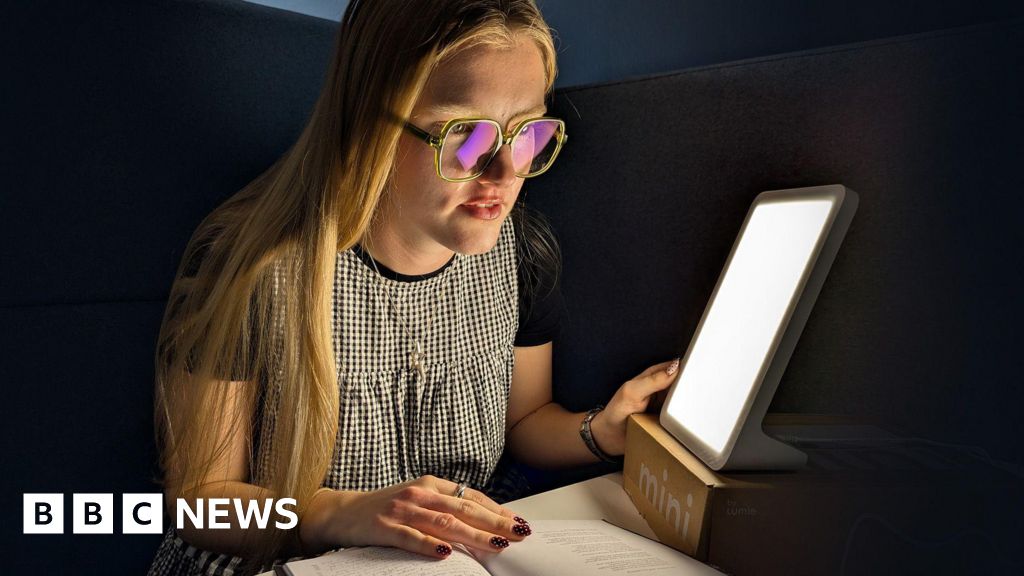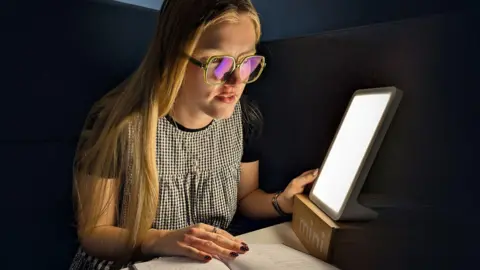 BBC
BBCAs the clocks go back and the darkness draws in, spare a thought for those living with the longest nights in the UK.
In the depths of winter, Scotland’s northern isles will see barely six hours of daylight from morning till night.
In London and the south, people will have about two more hours of light than islanders in Orkney and Shetland.
During these shorter days more than a million people in the UK experience symptoms of Seasonal Affective Disorder (Sad), according to the Royal College of Psychiatry.
These can include lowered mood, emotional difficulties and feelings of anxiety.
What is Seasonal Affective Disorder?
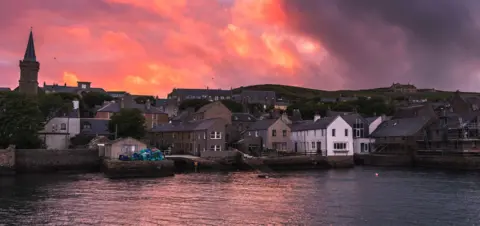 Getty Images
Getty Images- Sad is a recurring seasonal depression, common in winter, that is typically brought on by shorter days with reduced hours of daylight.
- It was identified in the early 1980s by Prof Norman Rosenthal, a South African psychiatrist working in the United States, who began using light therapy as a treatment.
- Symptoms of Sad described by the NHS can include low mood, irritability, a loss of interest in everyday activities and feeling sleepy during the day.
- Sufferers can also have feelings of despair, guilt and worthlessness, have difficulty concentrating and a decreased sex drive.
Life in remote locations, in the countryside or on islands, can be particularly challenging in the darker months, says Professor Hester Parr.
She leads the ‘Living with Sad’ project at the University of Glasgow.
“People with Sad routinely feel very depressed and sluggish,” she told BBC Scotland News.
“They find it difficult to socialise because they just don’t have the energy and motivation at this time of year.
“We work with those people to provide creative and cultural resources to encourage a more outdoor life, and give tips to build new ‘light routines’.”
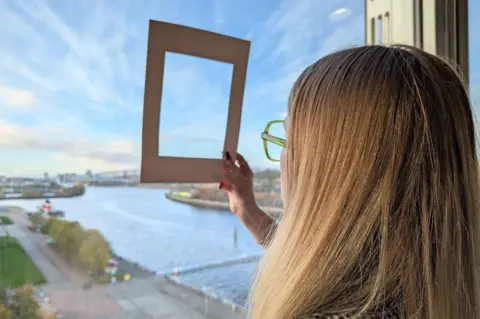
Prof Parr points out that people in rural communities often have limited access to social and medical support to help them through winter.
So for the first time this year, islanders on Orkney are being offered therapeutic lamps to help them cope with Sad and counter the effects of low light.
These will be handed out from libraries as part of ‘Wintering Well’ boxes.
The lamps come alongside an activity guide and tools to help people develop a routine for good mental health when daylight is in short supply.
Prof Parr says: “We’re pitching our resources at an attitudinal shift, a psychological mind-shift towards winter.
“So that we get out and enjoy winter, no matter what the weather.
“We’ve put that into a book and a CBT (Cognitive Behavioural Therapy) course in partnership with a psychiatrist.”
Tools in the box include a winter sky frame.
It’s a simple cardboard cut-out, that people are encouraged to hold for 10 minutes to observe a small patch of sky, to help lift their mood.
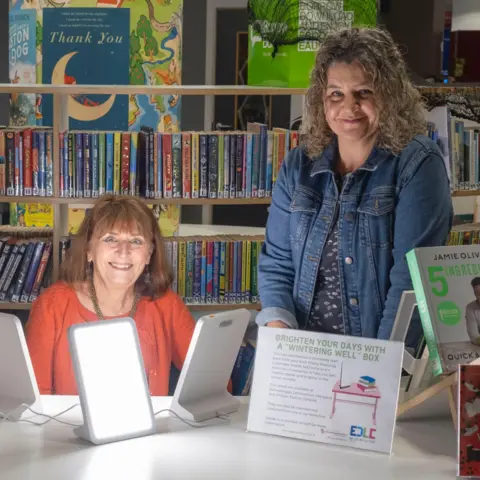 University of Glasgow
University of GlasgowProf Parr says the UK can also learn from Scandinavian nations where there is “a different cultural attitude to winter”.
She says creating an interior light environment that is cosy and comforting can help people cope with Sad.
“We tend to walk into winter thinking it is going to be one long dark season and that’s not actually true.
“If we do go outside there are large amounts of daylight available that does help our mental health.
“But it is not just about going outside and getting light, it is about redesigning our interior spaces.
“Using natural light through windows, but also using candles and fun lights to make the winter spaces in our homes more welcoming.”
Why are nights longer in the north?
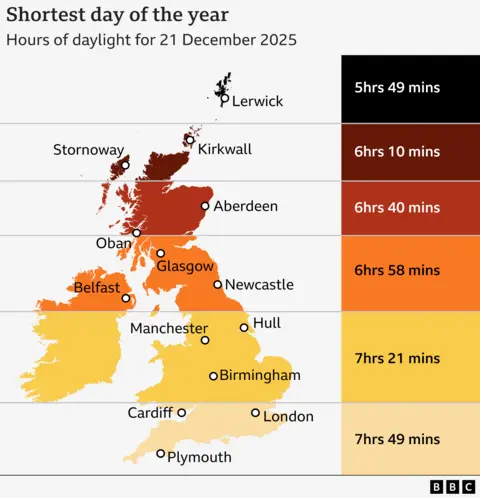
- The winter solstice is the shortest day of the year in the UK – with the fewest hours of daylight and longest night. This year it falls on 21 December.
- In northern Scotland the sun rises later and sets much earlier than southern England based on the Earth’s tilt away from the Sun
- On the winter solstice the difference is more than two hours of daylight between the most northern and southern parts of the UK.
- On 21 December at Penzance in Cornwall, the sun will rise at 08:18 and set at 16:21. That’s eight hours and three minutes of daylight.
- In Lerwick in Shetland it will rise at 09:08 and set at 14:57 – just five hours and 49 minutes of daylight.
The Orkney scheme is the next step in a project that was piloted in East Dunbartonshire in Scotland last winter.
It’s a joint project from the universities of Glasgow and Edinburgh, funded by UKRI (UK Innovation and Research).
About 100 Wintering Well boxes were made available, which were borrowed more than 200 times and renewed 349 times.
Orkney Library’s mobile van – known as Booky McBookface – will help distribute the light lamps across the islands.
Former librarian Stewart Bain, now a presenter on Radio Orkney, says the boxes will be welcomed by locals.
He says there is “no denying it can be a dark place” as the clocks go back.
“It’s getting to that stage that its dark when I’m going into work, dark when I’m coming home,” he says.
“Come the depths of winter it’ll be dark after three, at four o’clock pitch black.
“The lack of sunshine combined by the lack of exercise I think can have an impact.
“I think it definitely affects my mood. One of the key things for mental health is being able to get outside for a walk.”
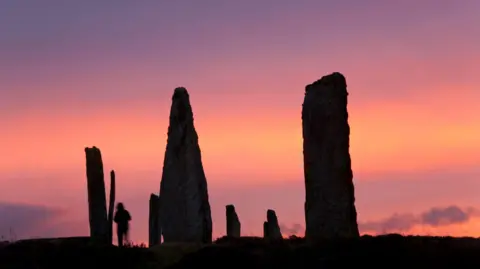 Getty Images
Getty ImagesStewart says using the Orkney library system to offer light lamps is the ideal solution.
“It’s great as another strand of what the library does,” he adds.
“The library is such a good thing for mental health anyway, it might be miserable and grey on Orkney, but you can be transported anywhere within the pages of a book.”
In Ireland, libraries in Dublin are also preparing to trial the scheme.
It has also inspired a new five-part series Winter Well on BBC Radio 4.
Prof Parr says the project has found that use of therapeutic lamps, alongside new outdoor routines and “programmatic encouragement” to notice natural light, really does make a difference for people with Sad.

